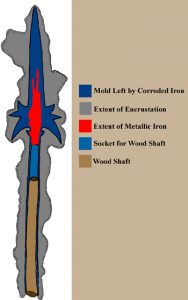Soil used to be cast aside: important only for the provenience of artifacts that were found. With modern technology; however, the matrix itself can provide valuable archaeological evidence. In the case of Tikal, an ancient Maya city in northern Guatemala, chemical analysis of soil has provided conclusive evidence of Maya agriculture (American Society of Agronomy 2012). Corn uses a different photosynthetic pathway than most of the vegetation native to Tikal and produces a higher ration of carbon-13 to carbon-12 in the soil (Eberl 2016). Richard Terry, a soil scientist at Brigham Young University, conducted research on 185 soil cores taken from around Tikal (Figure 1) which have been used to map where the Maya did and did not plant maize (Hollingshead 2013). With the model his team created of long-term corn production in Tikal, it is possible to determine the number of people the city could support (Hollingshead 2013). With this technique, it is then possible to look at modern soil and determine the population limit our agriculture can support before environmental collapse.

Figure 1. Soil scientists from Brigham Young University taking soil samples near Tikal, Gautemala (Gannon 2013).
Soil also provides direct evidence to overexploitation of resources, a problem that persists to this day. The Maya achieved widespread maize production but with this came invisible degenerative soil processes like erosion and fertility depletion (Olson 1981). Soil analysis in Tikal indicated that corn-production occurred mostly in low-lying wetlands called bajos, but erosion was discovered in upslope soils which suggested that farming had spread to hills (American Society of Agronomy 2012). It is likely that the spread of farming was due to increased demand because of population growth, but the larger production drastically affected soil viability and inevitably would have undercut the food source (American Society of Agronomy 2012). Again in Tikal, soil use was mapped based on the color: soil used for agricultural production was lighter than the mineral-rich soil which had been left undisturbed (Olson 1981) (Figure 2). The fact that the soil in Tikal has retained the nutrient character the Maya left it with for thousands of years is a sobering thought. Not only does overexploitation lead to decreased production in the relatively short-term but also affects the ability of future civilizations to survive in the far long-term. We not only need to consider the effects of our agriculture on how much food we can create for the present population, but also whether our supposed sustainability means future civilizations will be unable to survive. In order to maintain an ability for agricultural production the current rate of farming needs to decrease or needs to increase in variation (through consultation with experts on the nutrient use of each specific plant) so as to reduce mineral depletion.

Figure 2. An example of soil color being recorded with a Munsell Color Chart— to be recorded the soils must all be in the same conditions such as sunlight or shade and wet or dry (Maya Research Program).
Reference List:
American Society of Agronomy
2012 Researchers Unlock Ancient Maya Secrets with Modern Soil Science. Electronic document, https://www.sciencedaily.com/releases/2012/11/121112090732.htm, accessed November 2, 2018.
Eberl, Markus.
2016 Ancient Maya Agriculture at Tamarindito, Guatemala. Electronic document, https://my.vanderbilt.edu/universityfundingprograms/2016/11/ancient-maya-agriculture-at-tamarindito-guatemala/, accessed November 2, 2018.
Gannon, Megan.
2013 How Many Mayans Were There. Electronic document, https://www.livescience.com/37773-ancient-maya-farms-population.html, accessed November 2, 2018.
Hollingshead, Todd.
2013 Newly Revealed Maya Farming Hotspots Hold Key to Ancient Culture. Electronic document, https://news.byu.edu/news/newly-revealed-maya-farming-hotspots-hold-key-ancient-culture, accessed November 2, 2018.
Maya Research Program
2016 Soil Excavations with the Maya Research Program. Electronic document, https://munsell.com/color-blog/soil-excavation-maya-research-program/, accessed November 2, 2018.
Olson, Gerald W.
1981 Archaeology: Lessons On Future Soil Use. Electronic document, http://www.ciesin.columbia.edu/docs/002-225/002-225.html, accessed November 2, 2018.
Additional Content for Interested Readers:
Ballantyne, Marissa.
2007 BYU Research Team’s Special Methods Find Ancient Maya Marketplace. Electronic document, https://news.byu.edu/news/byu-research-teams-special-methods-find-ancient-maya-marketplace, accessed November 2, 2018.
Burnett, Richard L., Richard E. Terry, Ryan V. Sweetwood, David Webster, Tim Murtha, and Jay Silverstein
2012 Upland and Lowland Soil Resources of the Ancient Maya at Tikal, Guatemala. Electronic document, https://dl.sciencesocieties.org/publications/sssaj/abstracts/76/6/2083, accessed November 2, 2018.
Muhs, Daniel R., Robert R. Kautz, and J. Jefferson MacKinnon
1985 Soils and the Location of Cacao Orchards at a Maya site in Western Belize. Electronic document, https://www.sciencedirect.com/science/article/pii/0305440385900573, accessed November 2, 2018.


